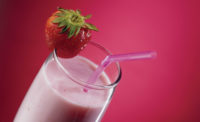Getting the texture right with cultured dairy foods
Sweet and savory flavors draw a lot of attention to new cultured dairy foods.

Often, flavor rules when it comes to consumer acceptability of foods. When it comes to cultured dairy foods, I might add “texture rules.”
I would venture to say that an acceptable texture is prerequisite to acceptance of any cultured milk product. Think about it: when a consumer puts a yogurt or other cultured milk product into her mouth, the first perception is likely a tactile sensation on the palate. Then flavors begin to enter the consumer “acceptability equation.” Finally, after swallowing, the mouth-coating (another texture attribute) may factor into the perception of the eating experience.
Even before they taste it, consumers look at the product, stir or shake it, obtain a sample on the spoon, pour it into a cup (or their mouths) or squeeze it out of the package. Each of these steps may give us some cues about the product’s overall texture acceptability. When yogurt flavors are less differentiated, textural attributes may become more important.
Texture attributes
While the optimal textural attributes of any yogurt depends on the application (drinkable versus spoonable, for example), there are some characteristics common to texture acceptability. Generally, desired yogurt textures have been described as “creamy.” And in a recent study, consumers agreed that creamy could be best described by two terms: smoothness and thickness.
Thickness is characterized by the manufacturer’s ability to transform a low-viscosity fluid (milk) into a thick, viscous material (yogurt, sour cream or cultured buttermilk). In some cases, excessive “wheying off or free whey” on the surface of the yogurt can be associated with low viscosity (unacceptable texture) when the free whey is reincorporated into the product upon stirring.
Smoothness is described as the absence of graininess, chalkiness and lumpiness. The perception of these defects creates an undesirable texture sensation on the palate that must be avoided or eliminated.
Achieving the desired viscosity
As I have written previously, effectively achieving the desired viscosity is about careful product formulation, processing prior to fermentation, culture selection, fermentation conditions and post-fermentation processing and handling. Conditions that create a fine pore gel structure will result in a firmer product with a creamier mouthfeel that will be less susceptible to wheying off.
These desired structure and texture outcomes are encouraged by having sufficient milk protein content in the mix that is heat-treated under the right conditions and at the right time. For example, yogurts made with milk supplemented with five commercially available whey protein concentrates had varying viscosity (thickness), depending on the degree of protein denaturation in the ingredients.
Lower fermentation temperatures and higher culture inoculation rates tend to produce fermented milk products with less whey separation and texture defects. Conversely, large whey protein aggregates (whey proteins denatured without the presence of milk caseins), poor culture incorporation into the milk and uneven heating (hot spots) in fermentation tanks will lead to graininess, chalkiness and other undesirable texture defects in the final product.
In some products, polysaccharides (stabilizers like pectin, starch and alginates) are used to provide water management and enhance viscosity. These polysaccharides can be economical and effective tools to provide higher viscosity and gel firmness with minimal to no whey off for many cultured product applications. However, improper use of starch and/or poor use of post-fermentation smoothing devices can lead to grainy-textured cultured milk products.
When milkfat is processed properly it provides superior textural eating quality to the product. By using proper homogenization conditions, fat-containing cultured milk products can have enhanced viscosities, no whey off and provide very pleasing eating qualities.
Texture solutions on the horizon
Recent studies on novel food processes may have value in improving yogurt texture. Researchers have demonstrated that four relatively new processes to the dairy industry may have some potential to improve yogurt texture. These are high-pressure processing, ultrasonic processing, protein crosslinking with transglutaminase and high-pressure homogenization.
In some cases, the benefit would be from improving the functionality of a dairy ingredient prior to incorporation into milk for fermentation. In other cases it would be to modify the properties of the entire milk mixture to enhance the overall texture of the product. While some of these technologies are in pilot-scale development, there is still more work to be completed to fully realize their value in large-scale cultured products manufacturing.
So while new flavors and packaging may get all the attention, insuring that the basic fermented milk product has high overall texture acceptability is a key part of consumers’ calculus in picking the most acceptable product to purchase.
Looking for a reprint of this article?
From high-res PDFs to custom plaques, order your copy today!






